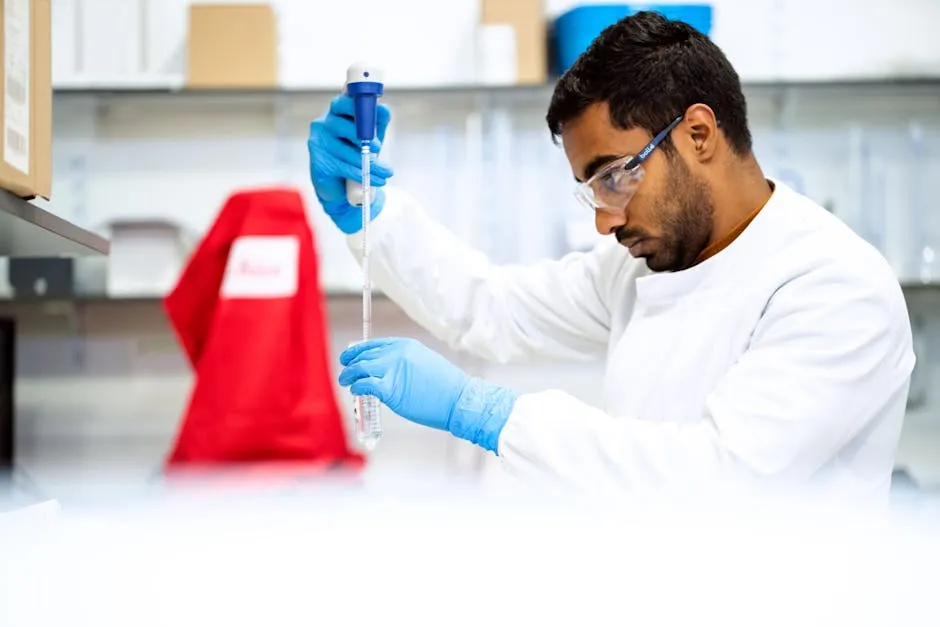Introduction
Welcome to the fascinating world of the Journal of Biopharmaceutical Statistics (JBS)! This journal is like the superhero of biopharmaceutical research, swooping in to save the day with its clever application of statistical methods. Since its first publication in 1991, JBS has become a vital resource for researchers and practitioners alike.
Imagine this: you’re on a quest to understand complex biopharmaceutical data. You need reliable statistical analysis, and that’s where JBS comes in. It publishes peer-reviewed articles that contribute significantly to the field. The journal focuses on original research that strengthens the application of statistics in biopharmaceutical contexts.
JBS has made a name for itself in the academic community. With a respectable impact factor, it ranks high among its peers. It’s not just another journal; it’s a valuable platform for sharing knowledge and fostering innovation. Researchers rely on JBS for guidance on statistical methodologies, ensuring their work adheres to the highest standards in biopharmaceutical research.
Over the years, JBS has become a beacon of knowledge, illuminating the intricacies of statistical applications. Whether you’re a seasoned researcher or just starting, this journal offers insights that can transform your understanding of biopharmaceutical statistics. With each issue, readers gain access to cutting-edge research, enhancing their ability to make data-driven decisions.

Speaking of data-driven decisions, if you’re looking to dive deeper into statistics, consider picking up “The Art of Statistics: Learning from Data” by David Spiegelhalter. This book will help you understand the beauty and intricacies of statistics, making it a must-have for any data enthusiast!
In a nutshell, the Journal of Biopharmaceutical Statistics stands as a cornerstone in its field. Its dedication to quality peer-reviewed content ensures that researchers and practitioners are equipped with the best statistical tools. So, buckle up, because we’re about to take a deeper look at its history and what makes JBS truly special!
History of the Journal
Establishment and Evolution
The Journal of Biopharmaceutical Statistics was established in 1991, thanks to the efforts of Taylor & Francis. Initially, its purpose was clear: to provide a specialized platform for the application of statistical methods in the biopharmaceutical sector. From the get-go, it targeted researchers, statisticians, and biopharmaceutical professionals who needed reliable information on statistical methodologies.
Over the years, the journal has seen several pivotal changes. Its publication frequency has evolved to six issues per year, ensuring that timely research reaches its readers without delay. This rapid publication cycle reflects the dynamic nature of the biopharmaceutical landscape, where new developments happen at lightning speed.
Editorial leadership has also played a crucial role in shaping JBS’s direction. Each editor has brought their unique vision and expertise, contributing to the journal’s ongoing evolution. As the journal matured, it adapted to the changing needs of its audience, embracing new statistical techniques and methodologies.
Milestones in the journal’s history include significant increases in the number of published articles and the expansion of its audience. Today, JBS continues to be a key player in the field, influencing biopharmaceutical research with its commitment to high-quality, peer-reviewed content. The journey from its humble beginnings to its current status is a testament to its importance in the scientific community.

Now, if you’re interested in understanding the practical aspects of statistical analysis in biopharmaceuticals, check out “Statistics for Biopharmaceuticals: A Practical Guide” by David Jones. This guide will equip you with the knowledge needed to navigate the statistical challenges in this field.
In conclusion, the Journal of Biopharmaceutical Statistics has carved out a niche for itself in biopharmaceutical research. Its establishment in 1991 marked the beginning of a valuable resource that continues to evolve and adapt to the needs of researchers worldwide. With its rich history and dedication to quality, JBS remains an essential read for anyone interested in the intersection of statistics and biopharmaceuticals.
Scope and Focus of the Journal
The Journal of Biopharmaceutical Statistics (JBS) is a pivotal resource in the realm of biopharmaceutical research. By emphasizing rigorous statistical methodologies, it addresses critical aspects of drug development and clinical trials. Researchers and practitioners alike rely on this journal for enlightening insights and innovative techniques. Let’s take a closer look at its scope and focus.

Research Areas Covered
Drug and Device Development
JBS covers diverse topics in drug and device development. This includes everything from the early stages of research to the final stages of product launch. The journal publishes studies that assess the effectiveness and safety of new therapies. These articles often utilize advanced statistical techniques to evaluate real-world outcomes.
Clinical Trials (Phase I, II, III)
Clinical trials are where the magic happens. JBS presents research on all phases of clinical trials. Phase I trials focus on safety and dosage, while Phase II emphasizes efficacy. Phase III trials are crucial for confirming effectiveness and monitoring side effects. Articles often highlight innovative designs and methodologies that enhance trial efficiency.
Bioavailability and Bioequivalence Studies
Bioavailability refers to the degree and rate at which a drug is absorbed into the bloodstream. Bioequivalence studies compare the bioavailability of two formulations. JBS publishes significant findings in this area, offering insights into drug formulation and regulatory compliance. This research is vital for ensuring that generic medications are as effective as their branded counterparts.
Pharmacokinetics and Pharmacodynamics
Understanding how drugs behave in the body is essential. Pharmacokinetics studies how the body absorbs, distributes, metabolizes, and excretes a drug. Conversely, pharmacodynamics examines the drug’s effects and mechanisms. JBS features research that employs sophisticated statistical models to analyze these processes, allowing researchers to make informed decisions about drug development.

If you’re keen on diving deeper into statistical methodologies, consider SAS for Windows. This powerful software is a go-to for many researchers when it comes to statistical analysis!
Statistical Methodologies
JBS is renowned for its focus on advanced statistical methodologies. These techniques are crucial for ensuring the reliability of research findings.
Generalized Estimating Equations (GEE)
GEE is a popular method for analyzing correlated data, especially in longitudinal studies. It accounts for the correlation between observations, providing robust parameter estimates. Articles published in JBS often showcase how GEE enhances the analysis of complex biopharmaceutical data.
Bayesian Methods
Bayesian statistics is gaining traction in biopharmaceutical research. This approach incorporates prior knowledge with current data to inform statistical models. JBS frequently publishes articles that apply Bayesian methods to clinical trial designs, making it an essential resource for researchers aiming to innovate their statistical approaches.
Big Data Analytics in Biopharmaceutical Research
The rise of big data has transformed biopharmaceutical research. JBS explores the applications of big data analytics in various contexts. This includes drug discovery, real-world evidence generation, and personalized medicine. The journal showcases studies that leverage large datasets, illustrating how advanced analytics can lead to groundbreaking insights.
In summary, the Journal of Biopharmaceutical Statistics encompasses a wide range of research areas and employs robust statistical methodologies. Its commitment to high-quality research and innovative statistical techniques makes it a vital resource for anyone involved in biopharmaceutical research. Whether it’s drug development, clinical trials, or advanced analytics, JBS provides the insights that drive the industry forward.

Publication Details
Frequency and Format
The Journal of Biopharmaceutical Statistics (JBS) publishes six issues each year. This frequency ensures that the latest research findings and methodologies reach readers promptly. It’s like a well-oiled machine, churning out insights just when you need them!
JBS accepts a variety of article types, catering to different research needs. Researchers can submit full-length studies that dive deep into intricate statistical models. Short manuscripts are also welcomed, providing a platform for concise, impactful findings. Additionally, the journal features reviews which summarize current trends and advancements in the field. It’s like having a buffet of statistical knowledge at your fingertips!
Whether you’re a seasoned researcher or just starting, JBS has something for everyone. The diversity of articles enriches the journal’s content, fostering a comprehensive understanding of biopharmaceutical statistics. So, grab your favorite snack, kick back, and get ready to munch on some serious statistical goodness!

Metrics
Let’s talk numbers! The Journal of Biopharmaceutical Statistics boasts impressive key metrics that reflect its standing in the academic community.
First up, the journal’s impact factor. As of the latest reports, JBS holds an impact factor of 0.587. This metric indicates the average number of citations received by articles published in the journal. It showcases the journal’s influence on the research community!
Next, we have the H-index, which stands at 56. This index measures both the productivity and citation impact of the publications. An H-index of 56 signifies that many articles published in JBS are highly cited, reinforcing its importance in the field.
The SCImago Journal Rank (SJR) is another crucial metric. The SJR has shown fluctuations over the years, but it currently stands at 0.812. This ranking reflects the journal’s prestige and the average prestige per article published. It’s like the journal’s popularity score, and JBS is definitely trending!
Lastly, let’s not forget about the total documents published. Since its inception in 1991, JBS has published over 1,600 documents, including research articles, reviews, and more. This wealth of information is a treasure trove for researchers and practitioners alike.
In summary, JBS is not just a journal; it’s a powerhouse of statistical knowledge. Its publication frequency, diverse article types, and impressive metrics make it an essential resource for anyone involved in biopharmaceutical research. So, keep those citations coming, because JBS is here to stay!

Peer Review Process
The peer review process is the backbone of academic integrity. It ensures the quality of published research. In the case of the Journal of Biopharmaceutical Statistics (JBS), this process involves several key steps. First, when an article is submitted, it undergoes an initial screening by the editorial team. They check for relevance and adherence to journal guidelines. If the manuscript passes this stage, it is sent to experts in the field for in-depth evaluation.
These reviewers assess the manuscript’s methodology, results, and conclusions. They provide constructive feedback, suggesting improvements or highlighting potential issues. This collaborative effort helps authors refine their work before publication. It’s like having a personal trainer for your research—pushing you to lift heavier and think deeper!
The importance of this rigorous review cannot be overstated. It maintains the journal’s credibility and ensures that readers receive reliable, high-quality information. In the fast-paced world of biopharmaceutical research, scrutiny is essential. Researchers and practitioners can trust that the findings published in JBS are both sound and significant.

Impact and Importance in Biopharmaceutical Research
Influence on Drug Development
The Journal of Biopharmaceutical Statistics has significantly influenced drug development processes. Through its focus on statistical methodologies, JBS has paved the way for more robust and efficient drug development strategies. Researchers have utilized the journal to share innovative statistical techniques that optimize clinical trials, leading to faster and more reliable outcomes.
For instance, a study published in JBS showcased a new Bayesian approach to clinical trial design. This method not only improved the efficiency of trials but also provided more accurate predictions of drug efficacy. One researcher noted, “JBS has been instrumental in advancing my understanding of statistical applications. The methodologies I learned here transformed my approach to drug development.”
Moreover, JBS promotes transparency in biopharmaceutical research. By providing a platform for detailed statistical analyses, the journal encourages researchers to share their data and findings openly. This openness fosters collaboration and innovation, which are crucial for the development of new therapies.

If you want to explore more about Bayesian methods, check out “Introduction to Bayesian Statistics” by Jay L. Devore. This book is a fantastic resource for anyone looking to delve into Bayesian methods!
Collaboration with Industry
Collaboration is at the heart of JBS’s mission. The journal partners with pharmaceutical companies, academic institutions, and regulatory agencies to enhance the quality of biopharmaceutical research. These partnerships are essential for bridging the gap between theory and practice.
Pharmaceutical companies often turn to JBS for guidance on statistical practices in clinical trials. The journal serves as a reference for best practices, ensuring that companies employ the most effective methodologies. Academic institutions benefit as well; they can leverage JBS as a resource for teaching and research.
Regulatory agencies also find value in JBS. The journal’s publications inform guidelines and standards for statistical analysis in drug development. By integrating the latest research findings, these agencies can make more informed decisions regarding the approval of new therapies.
In summary, the Journal of Biopharmaceutical Statistics is not just a publication; it’s a critical player in the biopharmaceutical landscape. Its influence on drug development processes and its collaborative efforts with industry stakeholders underscore its importance in advancing biopharmaceutical research. The journal continues to shape the field and drive innovations that benefit patients worldwide.

Future Directions
Emerging Trends
The landscape of biopharmaceutical statistics is evolving at breakneck speed. So, what’s trending? Let’s break it down. First, big data has arrived, and it’s not just a buzzword. It’s revolutionizing how researchers analyze vast datasets. The Journal of Biopharmaceutical Statistics (JBS) is adapting by publishing innovative studies that harness big data analytics. These studies offer insights that were previously impossible to obtain.
Artificial intelligence (AI) and machine learning (ML) are also making waves. These technologies are reshaping statistical methodologies. Researchers are now able to develop predictive models and automate analysis processes. The journal is keenly aware of this shift and is actively seeking articles that showcase AI and ML applications.
Imagine a world where AI assists in clinical trial designs or predicts patient responses based on historical data. That future is not far off, thanks to advancements in statistical methods. JBS is paving the way for these discussions, ensuring that researchers stay ahead of the curve.
Moreover, as the biopharmaceutical industry becomes increasingly data-driven, the demand for robust statistical methods rises. The journal is expected to adapt its publication strategies to include more articles focused on these methodologies. This means researchers who can marry statistical prowess with technological innovations will find a welcoming home at JBS.

Call for Submissions
Attention, researchers! The Journal of Biopharmaceutical Statistics invites you to contribute your work. Your diverse perspectives and innovative methodologies are essential for advancing the field. Whether you have groundbreaking findings or novel statistical approaches, we want to hear from you!
Why should you submit? Because this is your chance to be part of something big. JBS is committed to publishing high-quality research that shapes the future of biopharmaceutical statistics. Your work can help bridge the gap between theory and practice.
Remember, fresh ideas drive innovation. The journal thrives on a variety of contributions. So, put on your thinking cap, polish that manuscript, and share your insights with the world. Your research could spark the next big breakthrough in biopharmaceutical statistics!

Conclusion
In summary, the Journal of Biopharmaceutical Statistics stands as a cornerstone in biopharmaceutical research. With its focus on cutting-edge statistical methodologies and a commitment to quality, it plays a pivotal role in advancing the field. Emerging trends like big data and AI signal a bright future for the journal and its contributors.
Researchers can look forward to a platform that not only publishes their work but also elevates it. The call for submissions is an open invitation to join a community dedicated to innovation and excellence. So, whether you’re a seasoned statistician or a curious newcomer, JBS has something to offer you.
As we look ahead, the significance of the Journal of Biopharmaceutical Statistics cannot be overstated. Its potential for future contributions will undoubtedly shape the landscape of biopharmaceutical research for years to come. Let’s embrace the future together, armed with robust statistical methodologies and a spirit of collaboration!
Please let us know what you think about our content by leaving a comment down below!
Thank you for reading till here 🙂
All images from Pexels




